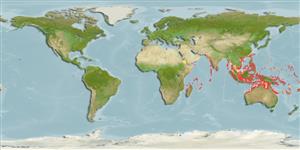Teleostei (teleosts) >
Clupeiformes (Herrings) >
Dorosomatidae (Gizzard shads and sardinellas)
Etymology: Sardinella: Latin and Greek, sarda = sardine; name related to the island of Sardinia; diminutive (Ref. 45335).
More on author: Cuvier.
Environment: milieu / climate zone / depth range / distribution range
Ecology
Marine; pelagic-neritic; amphidromous (Ref. 51243); depth range 0 - 50 m (Ref. 188). Tropical; 31°N - 27°S, 32°E - 168°W (Ref. 188)
Indo-West Pacific: Gulf of Aden south to Madagascar and Mauritius and east to the Arabian Sea and northwestern India (apparently not found south of Bombay nor in northern Bay of Bengal); then from Indonesia (but not in South China Sea) to Samoa. Reported from the Penghu Islands (Ref. 55073).
Size / Weight / Age
Maturity: Lm ? range ? - ? cm
Max length : 20.3 cm SL male/unsexed; (Ref. 3605); common length : 10.0 cm SL male/unsexed; (Ref. 188)
Dorsal spines (total): 0; Dorsal soft rays (total): 13 - 21; Anal spines: 0; Anal soft rays: 12 - 23. Body depth usually not much more than 30% of standard length; scutes 27 to 31. The jet black caudal tips distinguish S. melanura from all other species of Sardinella except S. atricauda (scutes 32 to 35), S. hualiensis (dark spot at dorsal fin origin, scales fimbriated and with small perforations) and S. fijiense (gill rakers 87 to 134).
Form schools in coastal waters (Ref. 188, 75154). Regarded a robust and very good bait in the tuna fishery.
Life cycle and mating behavior
Maturities | Reproduction | Spawnings | Egg(s) | Fecundities | Larvae
Whitehead, P.J.P., 1985. FAO Species Catalogue. Vol. 7. Clupeoid fishes of the world (suborder Clupeoidei). An annotated and illustrated catalogue of the herrings, sardines, pilchards, sprats, shads, anchovies and wolf-herrings. FAO Fish. Synop. 125(7/1):1-303. Rome: FAO. (Ref. 188)
IUCN Red List Status (Ref. 130435)
Threat to humans
Harmless
Human uses
Fisheries: minor commercial; bait: usually
Tools
Special reports
Download XML
Internet sources
Estimates based on models
Preferred temperature (Ref.
123201): 25.2 - 29.1, mean 28.2 °C (based on 1254 cells).
Phylogenetic diversity index (Ref.
82804): PD
50 = 0.5000 [Uniqueness, from 0.5 = low to 2.0 = high].
Bayesian length-weight: a=0.01096 (0.00661 - 0.01818), b=3.02 (2.88 - 3.16), in cm total length, based on LWR estimates for this species & Genus-body shape (Ref.
93245).
Trophic level (Ref.
69278): 2.9 ±0.3 se; based on size and trophs of closest relatives
Generation time: 1.6 ( na - na) years. Estimated as median ln(3)/K based on 2
growth studies.
Resilience (Ref.
120179): High, minimum population doubling time less than 15 months (tmax=4; k >0.7).
Fishing Vulnerability (Ref.
59153): Low vulnerability (20 of 100).
Nutrients (Ref.
124155): Calcium = 252 [133, 380] mg/100g; Iron = 1.82 [1.07, 3.32] mg/100g; Protein = 20.5 [19.6, 21.5] %; Omega3 = 0.293 [0.141, 0.586] g/100g; Selenium = 85.8 [44.9, 169.5] μg/100g; VitaminA = 32 [10, 96] μg/100g; Zinc = 1.17 [0.84, 1.62] mg/100g (wet weight);
